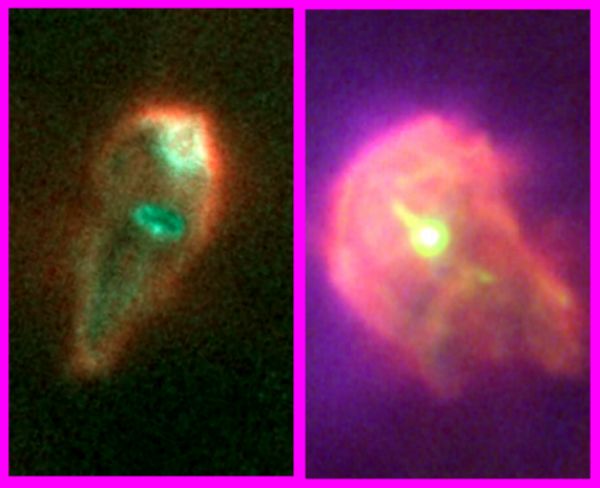Explanation: The Orion Nebula is a nuturing stellar nursery filled with hot young stars and their natal clouds of gas and dust. But for planetary systems, the active star-forming region can present a hazardous and inhospitable birthplace. While the formation of dusty protoplanetary disks seems common in Orion, these Hubble Space Telescope close-up images dramatically reveal the torturous conditions they must face while trying to grow into full-fledged planetary systems. In each case, a central young star is surrounded by a disk substantially wider than our solar system. The disks likely contain material in the process of planet formation. However, withering ultraviolet radiation from one of Orion's nearby hot stars is rapidly destroying the disks -- ultimately creating the comet-shaped clouds of glowing gas seen engulfing the protoplanetary systems. Planet formation must occur quickly here, if at all. Researchers estimate that about 90 percent of Orion's youngest protoplanetary disks will not survive the next 100,000 years.
1999 2000 2001 2002 2003 2004 2005 2006 2007 2008 2009 2010 2011 2012 2013 2014 2015 2016 2017 2018 2019 2020 2021 2022 2023 2024 2025 |
Январь Февраль Март Апрель Май Июнь Июль Август Сентябрь Октябрь Ноябрь Декабрь |
NASA Web Site Statements, Warnings, and Disclaimers
NASA Official: Jay Norris. Specific rights apply.
A service of: LHEA at NASA / GSFC
& Michigan Tech. U.
|
Публикации с ключевыми словами:
Протопланетные диски - protoplanetary disk - Orion Nebula - planet formation - Формирование планет - Туманность Ориона
Публикации со словами: Протопланетные диски - protoplanetary disk - Orion Nebula - planet formation - Формирование планет - Туманность Ориона | |
См. также:
Все публикации на ту же тему >> | |
